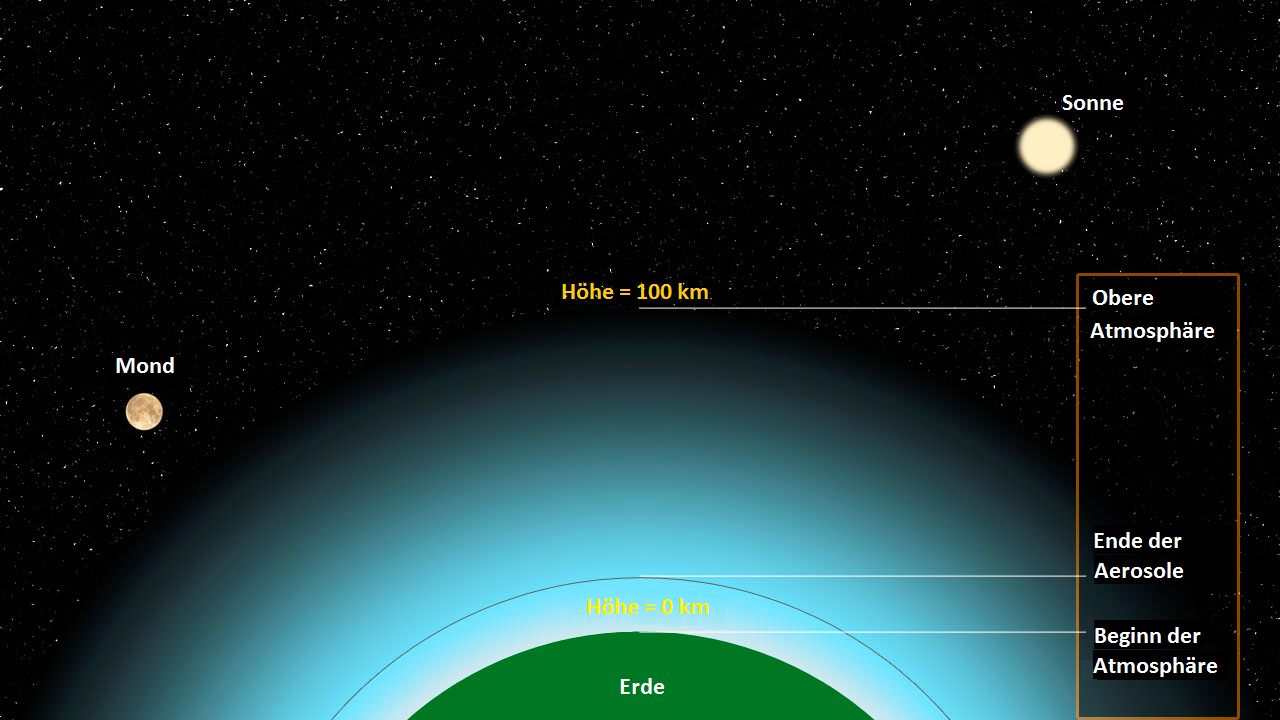RedSDK bietet ein physisch genaues Witterungsmodell inklusive:
- Tag-/Nacht-Simulation
- Vollständiges atmosphärisches Modell
- Genaue Position und Beleuchtung von Sonne und Mond
- Sterne
Dieses Modell wird unter Verwendung realer atmosphärischer und optischer Modelle und Daten dynamisch berechnet. Aus diesem Grund ist es vollständig parametrisch und kann dazu verwendet werden, um eine große Vielfalt an Witterungsbedingungen zu simulieren.
Sonnenaufgang in der Erdatmosphäre vom Weltall aus gesehen unter Verwendung unseres Witterungsmodells.
Modellbeschreibung
Die atmosphärische Struktur in unserem Modell lässt sich hauptsächlich durch zwei grundlegende Komponenten beschreiben: Luftmoleküle und Partikel (Aerosole). Luftmoleküle befinden sich überall und sind für die Blauverschiebung der Himmelsfarbe verantwortlich. Aerosole konzentrieren sich hauptsächlich am Boden und sind für die Diesigkeit des Himmels verantwortlich (Nebelmenge).
Schematische Ansicht der Atmosphäre in unserem Modell.
Die Anzahl der Luftmoleküle bleibt konstant mit einem real gemessenen Wert, jedoch hat der Anwender volle Kontrolle über die Anzahl der Aerosole und wie sie mit dem von der Sonne einfallenden Licht interagieren. Die Anzahl der in der Atmosphäre vorhandenen Aerosole wird durch den Wert des Trübheitsgrads gesteuert. In RedSDK kann der Trübheitsgrad zwischen 0 bis 100 variieren, wobei 0 für einen perfekten blauen Himmel und 100 für einen dichten, nebligen Himmel steht.
Sun and sky produce images where intensities can be far above the displayable range of intensities. The use of a tone mapping operator is absolutely necessary to correctly display such images
The same sky rendered with three turbidity values: from left to right, 0, 10, 50. Note how the amount of particles influences the appearance of the solar disc and the overall colour of the sky.
Depending on the kind of aerosols present in the atmosphere, the light going through them can be either mainly absorbed or scattered. In the previous figure, aerosols were mainly scattering the incoming sun light towards the observer. You can define the amount if incoming sun light which is scattered by the aerosols (the remaining part is absorbed): it's called aerosols albedo. 1 means 100% of incoming light is scattered (reflected) and 0 means fully opaque aerosols (100% of incoming light is absorbed).
The same sky rendered with constant turbidity and three aerosols albedo values: from left to right, 0, 0.5, 0.8. Lower albedo values tend to produce a darker sky (due to more light absorption).
Finally, the asymmetry factor determines how much of the light scattered by the aerosols is scattered toward or backward the observer.
The same sky rendered with constant turbidity and three asymmetry factor values: from left to right, -1.0 (backward scattering), 0.0 (isotropic scattering), 1.0 (forward scattering).
The albedo of the earth can also be taken into account. It describes the amount of solar energy reaching the ground which is reflected back to the atmosphere and varies a lot with the constituents of the ground (sand, rock, snow, water...). The effect of the earth albedo is more prominent when the sun is at its zenith.
Renderings of a clear sky with, from left to right, earth's albedo set to 0% (no reflection) to 100% (full reflection).
As our sky model relies on real equations and is fully dynamic, effects of the setting or rising sun are logically reproduced just by changing the position of the sun.
Rising sun as seen from the ground level.






